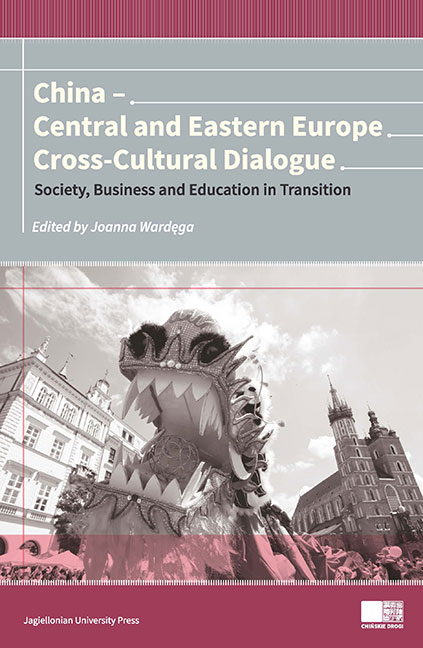Book contents
- Frontmatter
- Contents
- Foreword
- PART I Society and Culture in Transition
- PART TWO Economy and Markets in Transition
- Chinese Economic Influence on the Central and Eastern Europe Countries
- The New Silk Road and its Geopolitical Consequences for Poland
- Comparing Chinese, Japanese and South Korean FDI in Central and Eastern Europe
- Partnership through Investment – Chinese Foreign Direct Investment in CEE Countries
- Chinese Foreign Direct Investments in Europe. The Polish Case
- Fourteen EU States Already in, Japan and USA Still not Interested – What Lies Behind China-led AIIB?
- What Can CEE and China Learn from Each Other in Innovation?
- Comparison of Telecommunications Development Pattern in China and the Republic of Macedonia
- Development of Chinese Mobile Phone Game Market as an Export Opportunity for CEE Mobile Game Producers
- PART THREE Education in Transition
- Contributors
Chinese Economic Influence on the Central and Eastern Europe Countries
from PART TWO - Economy and Markets in Transition
Published online by Cambridge University Press: 22 December 2017
- Frontmatter
- Contents
- Foreword
- PART I Society and Culture in Transition
- PART TWO Economy and Markets in Transition
- Chinese Economic Influence on the Central and Eastern Europe Countries
- The New Silk Road and its Geopolitical Consequences for Poland
- Comparing Chinese, Japanese and South Korean FDI in Central and Eastern Europe
- Partnership through Investment – Chinese Foreign Direct Investment in CEE Countries
- Chinese Foreign Direct Investments in Europe. The Polish Case
- Fourteen EU States Already in, Japan and USA Still not Interested – What Lies Behind China-led AIIB?
- What Can CEE and China Learn from Each Other in Innovation?
- Comparison of Telecommunications Development Pattern in China and the Republic of Macedonia
- Development of Chinese Mobile Phone Game Market as an Export Opportunity for CEE Mobile Game Producers
- PART THREE Education in Transition
- Contributors
Summary
In recent years, China is becoming one of the most important players in the global economy. Its impressive growth, which is continuously realized for the last 35 years, has a great influence on the development of the modern world. This process accelerated significantly since 2001, when China acceded to the World Trade Organization. Two years earlier the PRC's government had announced the go out strategy. As a result, the Middle Kingdom developed international trade and began the process of transnational activity of Chinese companies. Although this led to an unprecedented economic growth of this country, the PRC is still in the period of transformation. It is seeking the best way to become a highly developed country.
As well as China, the Central and Eastern Europe countries are in the process of transition. Obviously, their situation is relevantly different from the Middle Kingdom, because it was the political uprising that started the transformation course. The economic changes were possible due to the fall of communism. The CEE countries regained independence and introduced the process of transition from the centrally planned economy to the market economy in the beginning of the 1990s. The simultaneous operation of political democratization and economic liberalization is nowadays still one of the biggest challenges for this states. However, it should be stressed that there are a lot of differences in the level and mode of the transformation processes in the particular CEE countries.
The paper aims to examine the geographical distribution of China's economic influence on the Central and Eastern Europe countries. The author used various data sources2 to prepare an analysis of the China- CEE trade and investment relations. It takes into account the data from 2004 to 2014. The results of the study are visualized in different illustrations. The body of the article consists of three main parts. Firstly, there is a short introduction into the China-CEE relations. Secondly, the author examines the bilateral trade cooperation. Thirdly, the flow of Chinese monetary capital to the European post-communist countries is investigated.
China-CEE cooperation
There is a visible revival in the relations between China and the CEE countries in the last few years. Since 2011, there is a yearly meeting of the representatives of the sixteen Central and Eastern Europe countries and China.
- Type
- Chapter
- Information
- China - Central and Eastern Europe Cross-Cultural Dialogue Society, Business and Education in Transition , pp. 167 - 182Publisher: Jagiellonian University PressPrint publication year: 2016



